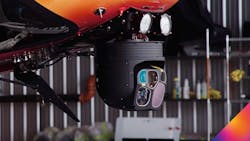Teledyne FLIR to provide maintenance parts for electro-optical sensors for surveillance and reconnaissance
CRANE, Ind. – U.S. Navy electro-optical sensors experts needed spare parts for several land- and sea-based sensors for intelligence, surveillance, and reconnaissance (ISR) applications. They found their solution from Teledyne FLIR LLC, a subsidiary of Teledyne Technologies in Wilsonville, Ore.
Officials of the Naval Surface Warfare Center Crane Division in Crane, Ind., announced a $43.9 contract to Teledyne FLIR late last month for spare parts for the Teledyne FLIR Sea Star Safire III, Brite Star II, Maritime 380HD, and TacFLIR 380HD electro-optical sensor systems.
The Sea Star Safire III is a rugged ship-mountable system to provide surface ships with a day and night high-resolution infrared and visible-light imaging and range finding capability to augment existing optical and radar sensors to detect and identify asymmetric threats.
The Brite Star II electro-optical system functions as the fire-control system for the Patrol Coastal Griffin missile system. It uses infrared and charge-coupled device (CCD) cameras to detect, identify, and track targets.
Related: Probing what the human eye cannot see
Brite Star II uses a laser range finder to determine the distance and position of the target and provides terminal guidance to the launched Griffin Missile seeker head with a laser designator. The sensor also includes a diode-pumped laser rangefinder and designator for long range target designation.
The small Griffin missile is fired from a common launch tube and is for Special Forces operations. It measures 43 inches long, weighs 33 pounds, and packs a 13-pound explosive warhead for low collateral damage.
The Star Safire 380-HD sensor combines color daylight digital camera and medium-wave infrared (MWIR) thermal-imaging camera in a motion-stabilized pod that is hardened for military fixed-wing aircraft, helicopters, aerostats, and other kinds of aircraft.
The Star Safire 380-HD, which has an optional shortwave infrared (SWIR) camera and laser rangefinder, illuminator, and pointer, embeds metadata in its video stream.
Related: Air Force orders electro-optical sensors for airborne surveillance from L-3 Sonoma
The optional SWIR sensor in the Star Safire 380-HD provides expanded multi-spectral day and night imaging with high definition mega-pixel resolution imagery. SWIR sensors can detect light from just beyond what the human eye can see to where infrared thermal imagers can perceive, and has the ability to see through windows and other kinds of glass, unlike medium- or long-wave infrared thermal imaging sensors.
SWIR light wavelengths are from 0.9 to 1.7 microns, and are reflective light, so its imagery has shadows and contrast. Since SWIR images are not in color, objects are easily to recognize. One big advantage of SWIR imaging sensors is their ability to use night sky radiance, which emits five to seven times more illumination than starlight -- nearly all of it in the SWIR wavelengths. As a result, SWIR imaging sensors use this night radiance to reveal objects clearly on moonless nights.
The Teledyne FLIR Systems Star Safire 380 thermal-imaging pod is for applications in surveillance and reconnaissance; search and rescue; maritime patrol; border patrol, unmanned aerial vehicles (UAVs); and force protection.
Related: Sensor payloads for unmanned vehicles
The thermal imager is an all-digital, full HD system in one line-replaceable unit. It has high-bandwidth HD-SDI video channels with symbology overlays that comply with government HD standards, providing 1080-pixel, 720-pixel, and other formats.
Sensor and geospatial data is embedded within the digital video stream, and the unit offers expanded multi-spectral imaging, with extended color imaging into the dark, and the unit can view, track, and mark ground locations using its embedded inertial measurement unit.
The Star 380 HD can follow moving targets with its multi-mode autotracker, and can illuminate wide areas covertly. It also can point out distant targets to other forces, and determine target distance and location. The thermal imager's all-weather design is qualified to MIL-STD-810 and 461.
The TacFLIR 380-HD is an intelligence, surveillance, target acquisition, and reconnaissance (ISTAR) sensor designed for land vehicle applications. Identical to airborne and maritime versions of the Star Safire 380-HD, TacFLIR 380-HD offers seals and shock mounts for land vehicle environments.
Payloads include a MWIR camera with a native 1280-by-720-pixel resolution, HD CCD cameras, HD SWIR camera, a laser range finder, and a laser pointer. Six-axis stabilization gives the TacFLIR 380-HD geolock and target-tracking capabilities.
On this contract Teledyne FLIR will do the work in Wilsonville, Ore., and should be finished by March 2027. For more information contact Teledyne FLIR online at www.flir.com, or the Naval Surface Warfare Center-Crane at www.navsea.navy.mil/Home/Warfare-Centers/NSWC-Crane.
About the Author
John Keller
Editor-in-Chief
John Keller is the Editor-in-Chief, Military & Aerospace Electronics Magazine--provides extensive coverage and analysis of enabling electronics and optoelectronic technologies in military, space and commercial aviation applications. John has been a member of the Military & Aerospace Electronics staff since 1989 and chief editor since 1995.
